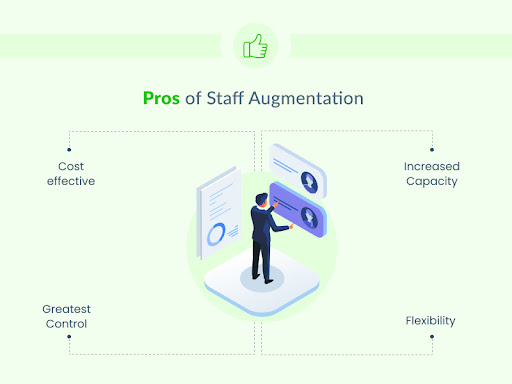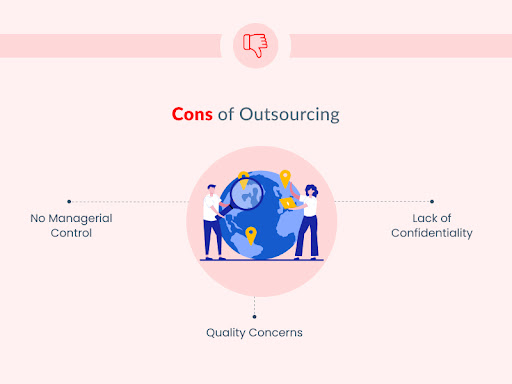
Although staff augmentation and outsourcing fall under the same category as staffing services, they are very different. Here is a quick comparison of staff augmentation vs. outsourcing a dedicated team to assist you in making an informed choice for your company’s smooth expansion and development.
Difference Between Staff Augmentation and Outsourcing
In this post, let’s discuss Staff Augmentation vs. Outsourcing services based on some significant factors.

Overview
IT staff augmentation is a method of outsourcing used to upgrade and upskill your software development team and increase their ability to meet business objectives. Without the liabilities associated with contract employees, you can increase the number of dedicated professionals in your development team on a short-term and long-term contract basis.
Outsourcing is similar to contracting with a software development provider to hire a dedicated development team of committed developers for a set amount of time. These outsourced developers must deliver all the IT services needed by a business. In contrast to technical assistance, application development, and technical support, outsourcing is more concerned with procedures and services.
Market Trends
With a CAGR of 3.53%, the IT Staff Augmentation services have experienced phenomenal growth. A study found that US$81.87 billion was spent worldwide on IT workforce augmentation.
The market for IT outsourcing was estimated to be worth 526.6 billion dollars in 2021, and by 2027, it is anticipated to reach 682.3 billion dollars. A 4.13% CAGR is projected for growth in IT outsourcing.
Statista and Globe Newswire predict that by 2026, the global outsourcing of IT services will be valued at $425.19 billion, while by 2025, the outsourcing of IT services in India will be worth $8,830.14 billion ($120.67 billion).
These figures make it abundantly evident that software outsourcing aims to maximize economic potential and create long-lasting partnerships with clients and employees.
Cost of Hiring & Infrastructure
In both models, the skilled developers are hired by a third party with a contract with the company. As a result, when contrasting outsourcing with staff augmentation, firms do not need to be concerned about employing developers or software engineers.
In the event of outsourcing, the team is based outside the company and performs its work remotely, resulting in lower costs. Therefore, there is no expense. However, in the event of employee expansion, the business needs to cover office space and training expenses. The organization also needs to oversee the short-term hired team.
Vendor Relationship
The success of a project is greatly influenced by the connection between the company and the vendor. The vendor participates directly in the project lifecycle when tasks are outsourced. Both sides must understand where they are both clear on the project’s concept.
The terms and conditions between the two sides must be disclosed for a better partnership. However, in staff augmentation, the vendor plays a considerably smaller role because firms engage with experts after the vendor has closed the sale.
Training
In this contrast of staff augmentation vs. outsourcing, the qualified individuals are employed in both situations by an outside organization. The external agencies guarantee they offer their clients highly skilled professionals.
When a project is outsourced, experts work on it and complete it in accordance with the terms and conditions and NDA documents. However, businesses must orient, onboard, and, if required, train the new hires while adding workers. This helps them to learn about the company’s culture, mission, vision, objectives, and goals.
Communication
The essential difference between staff augmentation and outsourcing is communication. Every project must have effective communication to succeed, especially if you outsource your software project or staff augmentation to an outside team.
In the case of staff augmentation, communication with the augmented team is simple due to the team’s physical presence in the workplace, which allows for direct contact.
However, outsourcing presents a different set of challenges. Your outsourcing workforce is dispersed globally and based in various time zones. Establishing communication with the entire team at once is typically not simpler.
Pros and Cons of Staff Augmentation and Outsourcing
Now, we know the difference between staff augmentation and outsourcing. Let’s examine the pros and cons of both of them for the software development process.
Pros of Staff Augmentation

Cost-effective:
Hiring augmented staff is a fantastic strategy to reduce costs compared to outsourcing. You can simply request the supplemental workers you require when you need them and pay them on a defined hourly rate and time duration rather than committing to hiring full-time permanent employees.
Since you will have more flexibility in how long you hire your augmented personnel, even though the hourly fee for augmented staff is more than that of permanent employees, you can save money in the long run.
Increased Capacity:
With the increase in your business, you’ll require more capable developers to do the development work. In these circumstances, staff augmentation can help you by allowing you to hire extra developers and finish the job.
They collaborate with your on-site personnel and boost your company’s overall productivity without additional expense. Many businesses use staff augmentation to expand personnel at busy times like the holidays and complete their task without diving further into the hiring and retention processes.
Greater Control:
When you hire an augmented staff, you have control over the work that the augmented staff does and how they contribute to the overall success of your project. Contrast this with staff outsourcing, where the external party will already have a project management system in place, decreasing your level of control over the project to some extent (not entirely)
Your internal project managers will handle an augmented staff. By this, you will have complete control over what they do, how they operate, and what they contribute to your project.
Flexibility:
Staff augmentation provides a high level of flexibility. This approach is renowned for its greater flexibility, whether it be in terms of working hours, technology, or even payment conditions.
As your developers work remotely, you can ask the developers to collaborate with your on-site team on your schedule. These adjustments are simple for them to handle. Additionally, they are eager to learn new technologies as and when required. They can easily adopt new technologies whenever required.
Furthermore, they offer freedom in terms of compensation; they might accept a fixed income or even an hourly pay rate. These developers allow you to select the best payment terms for your company.
Cons of Staff Augmentation

Risk of Team Conflict:
Adding new employees to an existing team can increase the chance of conflicts. Your augmented team may operate differently from your internal team. Because of this, it’s critical to have a robust onboarding procedure. Ensure your augmented team members know your company’s culture, working style, and standard practice for recognizing and addressing problems.
Load on Top Management:
If you’re fortunate enough to find a trustworthy vendor to hire more employees, you must train your senior management to oversee the group. The management burden grows as the number of employees rises.
You will be responsible for providing everything to your company’s augmented personnel. The team needs to be given everything, including a secure and healthy work environment, greater office space, mentoring, and more benefits.
Higher Expenses:
The higher-than-average hourly pay of your augmented workforce may cost you money if your project takes longer than anticipated. You must ensure that your project scope is realistic and reasonable from the start to help you avoid this issue.
Pros of Outsourcing

Access to Global Talent:
When you outsource IT services to foreign nations, you may connect with the top talent worldwide. This approach enables you to communicate with and access talent from around the world, which is quite impossible in an office environment.
The committed staff you contract out may be scattered globally and situated remotely. Hiring an outside team to handle your IT needs is one of the most significant advantages. You might not find a skilled worker with experience in the technology of your choice while recruiting locally.
However, companies like hiring Indian programmers since they may find superior possibilities for less money.
Enhanced Software Security:
The number of malicious attacks and vulnerabilities has also grown as the world begins to count the rewards of digitization and improved IT services. There are numerous data breaches and malware attacks have occurred.
When you hire a team to handle your needed IT services, you may connect with programmers with extensive experience creating software with improved security systems. If needed, these groups will also hire a time.
No Training or Onboarding:
You can avoid worrying about hiring new employees for your current company by outsourcing to reliable and respected software developers. Yes, even with outsourcing, there is still a lot of teamwork.
However, it is the responsibility of the outsourced company to inform their staff of your expectations and the preferred method of receiving project deliverables from them. This will help you spend less time and money on hiring, onboarding, and training.
Motivated In-house Employees:
There is no chance of upsetting or interrupting your current workforce because your outsourced team is not a part of your business. In-house workers may occasionally be reluctant to collaborate with temporary augmentation staff. They can worry that the enhanced personnel won’t be able to communicate effectively, agree on specific approaches and answers, or just fit in with the corporate culture.
However, outsourcing eliminates the possibility of internal conflict because the outsourced workforce operates apart from the rest of the internal staff.
Cons of Outsourcing

No Managerial Control:
When you collaborate with a company that outsources, they typically have their policies and processes in place for managing your project, or at least their contribution to your project.
You need to perform your research and work with a reputable outsourced development firm. The business should have a proven track record of working on initiatives comparable to yours, comprehending your vision, and producing a result that is in line with your goals.
Quality Concerns:
As the vendor gains direct authority over your project, the quality of the project is also shared. No one can assure the quality when you hire an offshore vendor to complete your project.
If any issue arises after the project is delivered, finding the person responsible for it is difficult. There may be some issues in coding, testing, and other technical debts.
Lack of Confidentiality:
When contrasting staff augmentation with outsourcing, this is one of the most important things to consider. All your source codes stay with the offshore vendor you use choose to outsource your project. This is because the outsourced team started the project from scratch.
You never know when your data might be compromised or when your codes might be published online. This could be disastrous for your business. When choosing an offshore vendor or development team, you must exercise extreme caution and sign an NDA with them.
Which One Should You Choose?
We have tried to cover the pros and cons of both the models in this blog. It now depends on your organizational needs and the project you wish to rent developers for. Depending on business needs, financial constraints, and the aforementioned factors, you can choose between staff augmentation and software outsourcing.
Also, Read this – https://www.recablog.com/finding-the-best-staffing-agencies-for-your-business/





